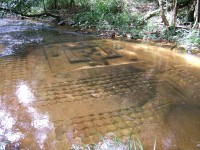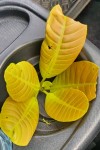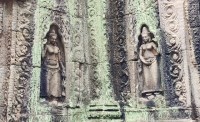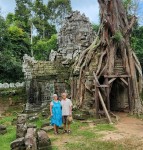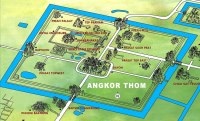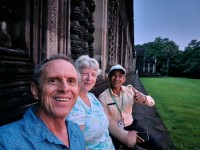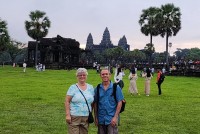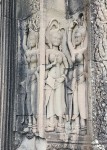Monday, September 25, Day 4
Neil and I have been listening to this Spotify playlist that Neil created for getting us into the mindset of our trip. We are including the link here if you would like to listen as you read and view photos. You might want to turn on shuffle so it skips around in the playlist.
 After all our hectic touring, we decided to have a down day in the morning. We showed up early for breakfast as usual and our sweet server asked us if we wanted a Cambodian dish that was part of the breakfast but they made it to order instead of on the buffet. I couldn’t quite understand her names for the dishes (one sounded like pumpkin curry) so we ordered one of each. It turns out they were both a noodle soup with meat and vegetables. We picked our favorite of them to order just one tomorrow. We also each had an omelet: so decadent.
After all our hectic touring, we decided to have a down day in the morning. We showed up early for breakfast as usual and our sweet server asked us if we wanted a Cambodian dish that was part of the breakfast but they made it to order instead of on the buffet. I couldn’t quite understand her names for the dishes (one sounded like pumpkin curry) so we ordered one of each. It turns out they were both a noodle soup with meat and vegetables. We picked our favorite of them to order just one tomorrow. We also each had an omelet: so decadent.
 We made arrangements with Mr. Thom to meet at 1:00 for him to drive us to lunch at Old Market. I had wanted to have Seafood Amok again at the place we ate the first night. Neil ordered a hot Khmer dish recommended by another tourist as her favorite dish that she had during her stay so far. We think the server mixed up the order because what arrived was a cold bland soup with lots of noodles and fresh vegetables on the side to add to the bowl. The flavor of the soup water had a nice peanut flavor but the whole experience of the dish was weird.
We made arrangements with Mr. Thom to meet at 1:00 for him to drive us to lunch at Old Market. I had wanted to have Seafood Amok again at the place we ate the first night. Neil ordered a hot Khmer dish recommended by another tourist as her favorite dish that she had during her stay so far. We think the server mixed up the order because what arrived was a cold bland soup with lots of noodles and fresh vegetables on the side to add to the bowl. The flavor of the soup water had a nice peanut flavor but the whole experience of the dish was weird.
 Neil wanted to look for a shirt similar to one Mr. Thom had on the day before (it had an upright collar.) We walked through the Old Market complex which seemed oriented toward the locals; there were stalls selling live seafood, and a few steps away there were chairs where local women were getting hair and nails done, next to that were stalls selling pots and pans and kitchen supplies, and nearby were some clothing stalls, wood carvings and fine art, flowers and decorations for your home shrine, and you name it. At the clothing shops, all the shirts were white, not what Neil wanted.
Neil wanted to look for a shirt similar to one Mr. Thom had on the day before (it had an upright collar.) We walked through the Old Market complex which seemed oriented toward the locals; there were stalls selling live seafood, and a few steps away there were chairs where local women were getting hair and nails done, next to that were stalls selling pots and pans and kitchen supplies, and nearby were some clothing stalls, wood carvings and fine art, flowers and decorations for your home shrine, and you name it. At the clothing shops, all the shirts were white, not what Neil wanted.  We ended up back at the shop on the street where Mr. Thom parked to wait for us, and we shopped at the same store where I got my wrap-around skirt the first night. They had the tan color in the shirt Neil liked but it had a sun fade line right in the front, sigh. He picked a green one instead.
We ended up back at the shop on the street where Mr. Thom parked to wait for us, and we shopped at the same store where I got my wrap-around skirt the first night. They had the tan color in the shirt Neil liked but it had a sun fade line right in the front, sigh. He picked a green one instead.
 Mr. Thom drove us to Wat Preah Prom Rath, (and a second link) the modern Temple and Pagoda in Siem Reap. We walked around and took a few photos before heading back to the hotel. We enjoyed an afternoon dip in the hotel swimming pool. The black bottom kept the water at a lovely temperature. If we had realized it was a salt water pool and not chlorine, we probably would have had a swim each day.
Mr. Thom drove us to Wat Preah Prom Rath, (and a second link) the modern Temple and Pagoda in Siem Reap. We walked around and took a few photos before heading back to the hotel. We enjoyed an afternoon dip in the hotel swimming pool. The black bottom kept the water at a lovely temperature. If we had realized it was a salt water pool and not chlorine, we probably would have had a swim each day.
 We started our trip with sunrise at Angkor Wat and book-ended it with a sunset view of Angkor Wat from the hill temple Phnom Bakheng (also RenownTravel link). Mr. Thom dropped us at the bottom of the hill and we walked up a dirt path to the top of the hill. On the way up there were several viewpoints. One was a view through the trees of the tower of Baksei Chamkrong. Higher up was a view of West Baray reservoir. Neil got a photo of it from the airplane when we arrived, but at the time we didn’t know what it was.
We started our trip with sunrise at Angkor Wat and book-ended it with a sunset view of Angkor Wat from the hill temple Phnom Bakheng (also RenownTravel link). Mr. Thom dropped us at the bottom of the hill and we walked up a dirt path to the top of the hill. On the way up there were several viewpoints. One was a view through the trees of the tower of Baksei Chamkrong. Higher up was a view of West Baray reservoir. Neil got a photo of it from the airplane when we arrived, but at the time we didn’t know what it was.  There wasn’t much of a sunset that night due to the cloud cover but from the top of the temple we watched an incredible lightning storm out over the city. It was quite dark by the time we reached the bottom of the hill where Mr. Thom was waiting for us.
There wasn’t much of a sunset that night due to the cloud cover but from the top of the temple we watched an incredible lightning storm out over the city. It was quite dark by the time we reached the bottom of the hill where Mr. Thom was waiting for us.
We wanted to visit the Night Market on our last night. It turns out there are two: an original and a new one across the river with fancy lighted bridges. We walked through both and we barely saw any other tourists. Nothing called to us to buy. We have had Cambodian food for every meal here which we enjoyed but tonight we decided to have Indian food which was delicious.
Tuesday, September 26, Day 5 Travel day to Phuket
 It was a rainy morning and when we went to breakfast, instead of a buffet, they had us order from a menu. We ordered the omelets and one bowl of Cambodian noodle soup to split. We couldn’t quite finish the soup but it was fun to have Cambodian food with our last meal.
It was a rainy morning and when we went to breakfast, instead of a buffet, they had us order from a menu. We ordered the omelets and one bowl of Cambodian noodle soup to split. We couldn’t quite finish the soup but it was fun to have Cambodian food with our last meal.
 After packing and settling our bill, we had a little time to relax before meeting Mr. Thom downstairs for our final ride to the airport. He was excited to take us to see more fire stations on the way; it was sweet of him, he really wanted us to be happy. As we pulled up to the airport, Neil commented that we never turned on the TV to see what the Cambodian channels looked like. We aren’t TV watchers and it doesn’t come up in our awareness, but it might have been interesting.
After packing and settling our bill, we had a little time to relax before meeting Mr. Thom downstairs for our final ride to the airport. He was excited to take us to see more fire stations on the way; it was sweet of him, he really wanted us to be happy. As we pulled up to the airport, Neil commented that we never turned on the TV to see what the Cambodian channels looked like. We aren’t TV watchers and it doesn’t come up in our awareness, but it might have been interesting.
A note about fire trucks. Earlier in the week we drove past a fire station on our way back from Angkor Wat and when we got to the hotel Neil asked Mr. Thom if we could stop by the station in the next day or two for a few photos. He was confused until Neil showed him a photo of Mailea and Daniel in front of the fire engine at the Wailea station (taken on Thanksgiving). Neil pointed to them and said ‘family’ and then it became Mr. Thom’s personal mission to find us a fire truck and firefighters. It wasn’t easy for him. Each time we saw him after that he would tell us he heard from some other tuk tuk driver about a possible fire station and did we want to go see it? We found old fire trucks with flat tires and covered with dust and obviously disused for years. Another time Mr. Thom sweet-talked a gate guard who let us through to see a truck in good repair. Turned out we had entered the Royal Palace through the service entrance and were viewing the royal fire station. Nobody was on duty because it is purely a volunteer force but one of the palace guards was a volunteer and he agreed to take a photo with Neil. Finally, on our last day on our way to the airport Mr. Thom took us to the airport fire station where there was a single firefighter on duty. Mr. Thom was so happy and relieved to have finally succeeded in his quest.
It wasn’t easy for him. Each time we saw him after that he would tell us he heard from some other tuk tuk driver about a possible fire station and did we want to go see it? We found old fire trucks with flat tires and covered with dust and obviously disused for years. Another time Mr. Thom sweet-talked a gate guard who let us through to see a truck in good repair. Turned out we had entered the Royal Palace through the service entrance and were viewing the royal fire station. Nobody was on duty because it is purely a volunteer force but one of the palace guards was a volunteer and he agreed to take a photo with Neil. Finally, on our last day on our way to the airport Mr. Thom took us to the airport fire station where there was a single firefighter on duty. Mr. Thom was so happy and relieved to have finally succeeded in his quest.
 Neil’s Notes: In our short stay I really warmed up to the Cambodian people. Aside from a few of the usual aggressive tourist shop owners found anywhere, the general public were polite and courteous and often genuinely sweet. You can see it in the smoothly flowing chaos of heavy traffic, and in the way friends, family, and strangers interact. Now that I think about it, devoutly Buddhist populations often have these traits. Similarly, I see this in rural populations anywhere, like in rural Iowa. I wish I could have gotten a photo of any of the many instances where children sandwiched between their parents on a motorcycle would playfully interact with me in the tuk tuk as we made our way down busy streets. We would make goofy faces back and forth to each other, or make funny hand waves back and forth. Often continuing until distance made it impossible.
Neil’s Notes: In our short stay I really warmed up to the Cambodian people. Aside from a few of the usual aggressive tourist shop owners found anywhere, the general public were polite and courteous and often genuinely sweet. You can see it in the smoothly flowing chaos of heavy traffic, and in the way friends, family, and strangers interact. Now that I think about it, devoutly Buddhist populations often have these traits. Similarly, I see this in rural populations anywhere, like in rural Iowa. I wish I could have gotten a photo of any of the many instances where children sandwiched between their parents on a motorcycle would playfully interact with me in the tuk tuk as we made our way down busy streets. We would make goofy faces back and forth to each other, or make funny hand waves back and forth. Often continuing until distance made it impossible.



































































